
A | B | C | D | E | F | G | H | CH | I | J | K | L | M | N | O | P | Q | R | S | T | U | V | W | X | Y | Z | 0 | 1 | 2 | 3 | 4 | 5 | 6 | 7 | 8 | 9
Maryland | |
|---|---|
| Nicknames: | |
Mottoes:
| |
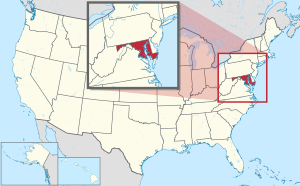 Map of the United States with Maryland highlighted | |
| Country | United States |
| Before statehood | Province of Maryland |
| Admitted to the Union | April 28, 1788 (7th) |
| Capital | Annapolis |
| Largest city | Baltimore |
| Largest county or equivalent | Montgomery |
| Largest metro and urban areas |
|
| Government | |
| • Governor | Wes Moore (D) |
| • Lieutenant Governor | Aruna Miller (D) |
| Legislature | General Assembly |
| • Upper house | Senate |
| • Lower house | House of Delegates |
| Judiciary | Supreme Court of Maryland |
| U.S. senators |
|
| U.S. House delegation |
|
| Area | |
| • Total | 12,407 sq mi (32,133 km2) |
| • Land | 9,776 sq mi (25,314 km2) |
| • Water | 2,633 sq mi (6,819 km2) 21% |
| • Rank | 42nd |
| Dimensions | |
| • Length | 250 mi (400 km) |
| • Width | 100 mi (200 km) |
| Elevation | 350 ft (110 m) |
| Highest elevation | 3,360 ft (1,024 m) |
| Lowest elevation | 0 ft (0 m) |
| Population | |
| • Total | 6,177,224 |
| • Rank | 18th |
| • Density | 632/sq mi (244/km2) |
| • Rank | 5th |
| • Median household income | $87,063 |
| • Income rank | 1st |
| Demonym | Marylander |
| Language | |
| • Official language | None (English, de facto) |
| Time zone | UTC−05:00 (Eastern) |
| • Summer (DST) | UTC−04:00 (EDT) |
| USPS abbreviation | MD |
| ISO 3166 code | US-MD |
| Traditional abbreviation | Md. |
| Latitude | 37° 53′ N to 39° 43′ N |
| Longitude | 75° 03′ W to 79° 29′ W |
| Website | maryland |
| List of state symbols | |
|---|---|
 | |
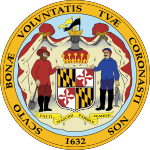 | |
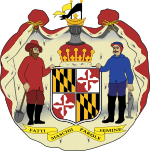 | |
| Song | None. Formerly: "Maryland, My Maryland" by James Ryder Randall (1861), (adopted 1939, repealed 2021) |
| Living insignia | |
| Bird | Baltimore oriole |
| Cat breed | Calico cat |
| Crustacean | Blue crab |
| Dog breed | Chesapeake Bay Retriever |
| Fish | Rock fish |
| Flower | Black-eyed Susan |
| Horse breed | Thoroughbred |
| Insect | Baltimore checkerspot butterfly |
| Reptile | Diamondback terrapin |
| Tree | White oak |
| Inanimate insignia | |
| Beverage | Milk |
| Dance | Square dance |
| Dinosaur | Astrodon johnstoni |
| Food | Smith Island cake |
| Fossil | Ecphora gardnerae gardnerae |
| Gemstone | Patuxent River stone |
| Ship | Skipjack |
| Sport | |
| State route marker | |
 | |
| State quarter | |
 Released in 2000 | |
| Lists of United States state symbols | |
Maryland (US: /ˈmɛrɪlənd/ MERR-il-ənd)[b] is a state in the Mid-Atlantic region of the United States.[8][9] The state borders Virginia to its south, West Virginia to its west, Pennsylvania to its north, Delaware to its east, the Atlantic Ocean, and the national capital of Washington, D.C. With a total area of 12,407 square miles (32,130 km2), Maryland is the ninth-smallest state by land area,[10] and its population of 6,177,224 ranks it the 18th-most populous state and the fifth-most densely populated. Maryland's capital is Annapolis, and the most populous city is Baltimore.[11] Occasional nicknames include Old Line State, the Free State, and the Chesapeake Bay State. It is named after Henrietta Maria, the French-born queen of England, Scotland, and Ireland during the 17th century.[12][13]
Maryland's coastline was first explored by Europeans in the 16th century. Prior to that, it was inhabited by several Native American tribes, mostly the Algonquian peoples and, to a lesser degree, Iroquoians and Siouans.[14] As one of the original Thirteen Colonies, Maryland was founded by George Calvert, 1st Baron Baltimore, a Catholic convert[15][16] who sought to provide a religious haven for Catholics persecuted in England.[17] In 1632, Charles I of England granted Lord Baltimore a colonial charter, naming the colony after his wife, Henrietta Maria.[18] Unlike the Pilgrims and Puritans, Lord Baltimore envisioned a colony where people of different religious sects would coexist under the principle of toleration.[17] In 1649, the Maryland General Assembly passed an Act Concerning Religion, which enshrined this principle by penalizing anyone who "reproached" a fellow Marylander based on religious affiliation.[19] Nevertheless, religious strife was common in the early years, and Catholics remained a minority, albeit in greater numbers than in any other English colony. Maryland's early settlements and population centers clustered around rivers and other waterways that empty into the Chesapeake Bay. Its economy was heavily plantation-based and centered mostly on the cultivation of tobacco. Demand for cheap labor from Maryland colonists led to the importation of numerous indentured servants and enslaved Africans. In 1760, Maryland's current boundaries took form following the settlement of a long-running border dispute with Pennsylvania. Maryland was an active participant in the events leading up to the American Revolution, and by 1776, its delegates signed the Declaration of Independence. Many of its citizens subsequently played key political and military roles in the war. Although then a slave state, Maryland remained in the Union during the American Civil War, its strategic location giving it a significant role in the conflict. After the Civil War, Maryland took part in the Industrial Revolution, driven by its seaports, railroad networks, and mass immigration from Europe.
Since the 1940s, the state's population has grown rapidly, to approximately six million residents, and it is among the most densely populated U.S. states. As of 2015[update], Maryland had the highest median household income of any state, owing in large part to its proximity to Washington, D.C., and a highly diversified economy spanning manufacturing, retail services, public administration, real estate, higher education, information technology, defense contracting, health care, and biotechnology.[20] Maryland is one of the most multicultural states in the country; it is one of the six states where non-Whites compose a majority of the population, with the fifth-highest percentage of African Americans, and high numbers of residents born in Africa, Asia, Central America, and the Caribbean. The state's central role in U.S. history is reflected by its hosting of some of the highest numbers of historic landmarks per capita.
The western portion of the state contains numerous stretches of the Appalachian Mountains, the central portion is primarily composed of the Piedmont, and the eastern side of the state makes up a significant portion of Chesapeake Bay. Sixteen of Maryland's twenty-three counties, as well as the city of Baltimore, border the tidal waters of the Chesapeake Bay estuary and its many tributaries,[21][11] which combined total more than 4,000 miles of shoreline. Although one of the smallest states in the U.S., it features a variety of climates and topographical features that have earned it the moniker of America in Miniature.[22] In a similar vein, Maryland's geography, culture, and history combine elements of the Mid-Atlantic, Northeastern, and Southern regions of the country.
History
17th century
Maryland's first colonial settlement
George Calvert, 1st Baron Baltimore (1579–1632), sought a charter from King Charles I for the territory between Massachusetts to the north and Virginia to the immediate south.[23] After Baltimore died in April 1632, the charter was granted to his son, Cecilius Calvert, 2nd Baron Baltimore (1605–1675), on June 20, 1632. Officially, the new "Maryland Colony" was named in honor of Henrietta Maria of France, wife of Charles I.[24] Lord Baltimore initially proposed the name "Crescentia", the land of growth or increase, but "the King proposed Terra Mariae , which was concluded on and Inserted in the bill."[17]
The original capital of Maryland was St. Mary's City, on the north shore of the Potomac River, and the county surrounding it, the first erected/created in the province,[25] was first called Augusta Carolina, after the King, and later named St. Mary's County.[26]
Lord Baltimore's first settlers arrived in the new colony in March 1634, with his younger brother the Honorable Leonard Calvert (1606–1647), as first provincial Governor of Maryland. They made their first permanent settlement at St. Mary's City in what is now St. Mary's County. They purchased the site from the paramount chief of the region, who was eager to establish trade. St. Mary's became the first capital of Maryland, and remained so for 60 years until 1695. More settlers soon followed. Their tobacco crops were successful and quickly made the new colony profitable. However, given the incidence of malaria, yellow fever, and typhoid, life expectancy in Maryland was about 10 years less than in New England.[27]
Persecution of Catholics
Maryland was founded to provide a haven for England's Roman Catholic minority.[28] Although Maryland was the most heavily Catholic of the English mainland colonies, the religion was still in the minority, consisting of less than 10% of the total population.[29]
In 1642, a number of Puritans left Virginia for Maryland and founded Providence (now called Annapolis) on the western shore of the upper Chesapeake Bay.[30] A dispute with traders from Virginia over Kent Island in the Chesapeake led to armed conflict. In 1644, William Claiborne, a Puritan, seized Kent Island while his associate, the pro-Parliament Puritan Richard Ingle, took over St. Mary's.[31] Both used religion as a tool to gain popular support. The two years from 1644 to 1646 when Claiborne and his Puritan associates held sway were known as "The Plundering Time". They captured Jesuit priests, imprisoned them, then sent them back to England.
In 1646, Leonard Calvert returned with troops, recaptured St. Mary's City, and restored order. The House of Delegates passed the "Act concerning Religion" in 1649 granting religious liberty to all Trinitarian Christians.[27]
In 1650, the Puritans revolted against the proprietary government. "Protestants swept the Catholics out of the legislature ... and religious strife returned."[27] The Puritans set up a new government prohibiting both Roman Catholicism and Anglicanism. The Puritan revolutionary government persecuted Maryland Catholics during its reign, known as the "plundering time". Mobs burned down all the original Catholic churches of southern Maryland. The Puritan rule lasted until 1658 when the Calvert family and Lord Baltimore regained proprietary control and re-enacted the Toleration Act.
After England's "Glorious Revolution" of 1688, Maryland outlawed Catholicism. In 1704, the Maryland General Assembly prohibited Catholics from operating schools, limited the corporate ownership of property to hamper religious orders from expanding or supporting themselves, and encouraged the conversion of Catholic children.[29] The celebration of the Catholic sacraments was also officially restricted. This state of affairs lasted until after the American Revolutionary War (1775–1783). Wealthy Catholic planters built chapels on their land to practice their religion in relative secrecy.
Into the 18th century, individual priests and lay leaders claimed Maryland farms belonging to the Jesuits as personal property and bequeathed them in order to evade the legal restrictions on religious organizations' owning property.[29]
Border disputes (1681–1760)

The royal charter granted Maryland the land north of the Potomac River up to the 40th parallel. A problem arose when Charles II granted a charter for Pennsylvania. The grant defined Pennsylvania's southern border as identical to Maryland's northern border, the 40th parallel. But the grant indicated that Charles II and William Penn assumed the 40th parallel would pass close to New Castle, Delaware when it falls north of Philadelphia, the site of which Penn had already selected for his colony's capital city. Negotiations ensued after the problem was discovered in 1681.
A compromise proposed by Charles II in 1682 was undermined by Penn's receiving the additional grant of what is now Delaware.[33] Penn successfully argued that the Maryland charter entitled Lord Baltimore only to unsettled lands, and Dutch settlement in Delaware predated his charter. The dispute remained unresolved for nearly a century, carried on by the descendants of William Penn and Lord Baltimore—the Calvert family, which controlled Maryland, and the Penn family, which controlled Pennsylvania.[33]
The border dispute with Pennsylvania led to Cresap's War in the 1730s. Hostilities erupted in 1730 and escalated through the first half of the decade, culminating in the deployment of military forces by Maryland in 1736 and by Pennsylvania in 1737. The armed phase of the conflict ended in May 1738 with the intervention of King George II, who compelled the negotiation of a cease-fire. A provisional agreement had been established in 1732.[33]
Negotiations continued until a final agreement was signed in 1760. The agreement defined the border between Maryland and Pennsylvania as the line of latitude now known as the Mason–Dixon line. Maryland's border with Delaware was based on a Transpeninsular Line and the Twelve-Mile Circle around New Castle.[33]
18th century
Most of the English colonists arrived in Maryland as indentured servants, and had to serve a several years' term as laborers to pay for their passage.[34] In the early years, the line between indentured servants and African slaves or laborers was fluid, and white and black laborers commonly lived and worked together, and formed unions. Mixed-race children born to white mothers were considered free by the principle of partus sequitur ventrem, by which children took the social status of their mothers, a principle of slave law that was adopted throughout the colonies, following Virginia in 1662.
Many of the free black families migrated to Delaware, where land was cheaper.[35] As the flow of indentured laborers to the colony decreased with improving economic conditions in England, planters in Maryland imported thousands more slaves and racial caste lines hardened.
Maryland was one of the thirteen colonies that revolted against British rule in the American Revolution. Near the end of the American Revolutionary War (1775–1783), on February 2, 1781, Maryland became the last and 13th state to approve the ratification of the Articles of Confederation and Perpetual Union, first proposed in 1776 and adopted by the Second Continental Congress in 1778, which brought into being the United States as a united, sovereign and national state. It also became the seventh state admitted to the Union after ratifying the new federal Constitution in 1788. In December 1790, Maryland donated land selected by first President George Washington to the federal government for the creation of the new national capital of Washington, D.C. The land was provided along the north shore of the Potomac River from Montgomery and Prince George's counties, as well as from Fairfax County and Alexandria on the south shore of the Potomac in Virginia; however, the land donated by the Commonwealth of Virginia was later returned to that state by the District of Columbia retrocession in 1846.
19th century

Influenced by a changing economy, revolutionary ideals, and preaching by ministers, numerous planters in Maryland freed their slaves in the 20 years after the Revolutionary War. Across the Upper South the free black population increased from less than 1% before the war to 14% by 1810.[36] Abolitionists Harriet Tubman and Frederick Douglass were born slaves during this time in Dorchester County and Talbot County, respectively.[37][38]
During the War of 1812, the British military attempted to capture Baltimore, which was protected by Fort McHenry. During its bombardment the song "The Star-Spangled Banner" was written by Francis Scott Key; it was later adopted as the national anthem.
The National Road (U.S. Hwy 40 today) was authorized in 1817 and ran from Baltimore to St. Louis—the first federal highway. The Baltimore and Ohio Railroad (B&O) was the first chartered railroad in the United States. It opened its first section of track for regular operation in 1830 between Baltimore and Ellicott City,[39] and in 1852 it became the first rail line to reach the Ohio River from the eastern seaboard.[40]
Civil War

The state remained with the Union during the Civil War,[41] due in significant part to demographics and Federal intervention. The 1860 census, held shortly before the outbreak of the civil war, showed that 49% of Maryland's African Americans were free.[36]
Governor Thomas Holliday Hicks suspended the state legislature, and to help ensure the election of a new pro-union governor and legislature, President Abraham Lincoln had a number of its pro-slavery politicians arrested, including the Mayor of Baltimore, George William Brown; suspended several civil liberties, including habeas corpus; and ordered artillery placed on Federal Hill overlooking Baltimore.
In April 1861, Federal units and state regiments were attacked as they marched through Baltimore, sparking the Baltimore riot of 1861, the first bloodshed in the Civil War.[42] Of the 115,000 Marylanders who joined the military during the Civil War, around 85,000, or 77%, joined the Union army, while the remainder joined the Confederate Army.[citation needed] The largest and most significant battle in the state was the Battle of Antietam on September 17, 1862, near Sharpsburg. Although a tactical draw, the battle was considered a strategic Union victory and a turning point of the war.
After the war
A new state constitution in 1864 abolished slavery and Maryland was first recognized as a "Free State" in that context.[43] Following passage of constitutional amendments that granted voting rights to freedmen, in 1867 the state extended suffrage to non-white males.
The Democratic Party rapidly regained power in the state from Republicans. Democrats replaced the Constitution of 1864 with the Constitution of 1867. Following the end of Reconstruction in 1877, Democrats devised means of disenfranchising blacks, initially by physical intimidation and voter fraud, later by constitutional amendments and laws. Blacks and immigrants, however, resisted Democratic Party disfranchisement efforts in the state. Maryland blacks were part of a biracial Republican coalition elected to state government in 1896–1904 and comprised 20% of the electorate.[44]
Compared to some other states, blacks were better established both before and after the civil war. Nearly half the black population was free before the war, and some had accumulated property. Half the population lived in cities. Literacy was high among blacks and, as Democrats crafted means to exclude them, suffrage campaigns helped reach blacks and teach them how to resist.[44] Whites did impose racial segregation in public facilities and Jim Crow laws, which effectively lasted until the passage of federal civil rights legislation in the mid-1960s.
Baltimore grew significantly during the Industrial Revolution, due in large part to its seaport and good railroad connections, attracting European immigrant labor. Many manufacturing businesses were established in the Baltimore area after the Civil War. Baltimore businessmen, including Johns Hopkins, Enoch Pratt, George Peabody, and Henry Walters, founded notable city institutions that bear their names, including respectively a university, library system, music and dance conservatory, and art museum.
Cumberland was Maryland's second-largest city in the 19th century. Nearby supplies of natural resources along with railroads fostered its growth into a major manufacturing center.[45]
20th and 21st centuries
Early 20th century

The Progressive Era of the late 19th and early 20th centuries brought political reforms. In a series of laws passed between 1892 and 1908, reformers worked for standard state-issued ballots (rather than those distributed and marked by the parties); obtained closed voting booths to prevent party workers from "assisting" voters; initiated primary elections to keep party bosses from selecting candidates; and had candidates listed without party symbols, which discouraged the illiterate from participating. These measures worked against ill-educated whites and blacks. Blacks resisted such efforts, with suffrage groups conducting voter education. Blacks defeated three efforts to disenfranchise them, making alliances with immigrants to resist various Democratic campaigns.[44] Disenfranchisement bills in 1905, 1907, and 1911 were rebuffed, in large part because of black opposition. Blacks comprised 20% of the electorate and immigrants comprised 15%, and the legislature had difficulty devising requirements against blacks that did not also disadvantage immigrants.[44]
The Progressive Era also brought reforms in working conditions for Maryland's labor force. In 1902, the state regulated conditions in mines; outlawed child laborers under the age of 12; mandated compulsory school attendance; and enacted the nation's first workers' compensation law. The workers' compensation law was overturned in the courts, but was redrafted and finally enacted in 1910.
The Great Baltimore Fire of 1904 burned for more than 30 hours, destroying 1,526 buildings and spanning 70 city blocks. More than 1,231 firefighters worked to bring the blaze under control.
With the nation's entry into World War I in 1917, new military bases such as Camp Meade, the Aberdeen Proving Ground, and the Edgewood Arsenal were established. Existing facilities, including Fort McHenry, were greatly expanded.
After Georgia congressman William D. Upshaw criticized Maryland openly in 1923 for not passing Prohibition laws, Baltimore Sun editor Hamilton Owens coined the "Free State" nickname for Maryland in that context, which was popularized by H. L. Mencken in a series of newspaper editorials.[43][46]
Maryland's urban and rural communities had different experiences during the Great Depression. The "Bonus Army" marched through the state in 1932 on its way to Washington, D.C. Maryland instituted its first income tax in 1937 to generate revenue for schools and welfare.[47]
Passenger and freight steamboat service, once important throughout Chesapeake Bay and its many tributary rivers, ended in 1962.[48]
Baltimore was a major war production center during World War II. The biggest operations were Bethlehem Steel's Fairfield Yard, which built Liberty ships; and Glenn Martin, an aircraft manufacturer.
1950–present
Maryland experienced population growth following World War II. Beginning in the 1960s, as suburban growth took hold around Washington, D.C. and Baltimore, the state began to take on a more mid-Atlantic culture as opposed to the traditionally Southern and Tidewater culture that previously dominated most of the state. Agricultural tracts gave way to residential communities, some of them carefully planned such as Columbia, St. Charles, and Montgomery Village. Concurrently the Interstate Highway System was built throughout the state, most notably I-95, I-695, and the Capital Beltway, altering travel patterns. In 1952, the eastern and western halves of Maryland were linked for the first time by the Chesapeake Bay Bridge, which replaced a nearby ferry service.[49]
Maryland's regions experienced economic changes following WWII. Heavy manufacturing declined in Baltimore. In Maryland's four westernmost counties, industrial, railroad, and coal mining jobs declined. On the lower Eastern Shore, family farms were bought up by major concerns and large-scale poultry farms and vegetable farming became prevalent. In Southern Maryland, tobacco farming nearly vanished due to suburban development and a state tobacco buy-out program in the 1990s.
In an effort to reverse depopulation due to the loss of working-class industries, Baltimore initiated urban renewal projects in the 1960s with Charles Center and the Baltimore World Trade Center. Some resulted in the break-up of intact residential neighborhoods, producing social volatility, and some older residential areas around the harbor have had units renovated and have become popular with new populations.
Geography

Maryland has an area of 12,406.68 square miles (32,133.2 km2) and is comparable in overall area with Belgium .[50] It is the 42nd-largest and 9th-smallest state and is closest in size to the state of Hawaii , the next smallest state. The next largest state is Maryland's neighbor, West Virginia, which is nearly twice the size of Maryland .
Description
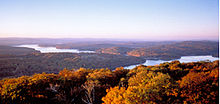



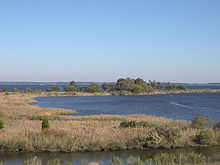
Maryland possesses a variety of topography within its borders, contributing to its nickname America in Miniature.[51] It ranges from sandy dunes dotted with seagrass in the east, to low marshlands teeming with wildlife and large bald cypress near the Chesapeake Bay, to gently rolling hills of oak forests in the Piedmont Region, and pine groves in the Maryland mountains to the west.
Maryland is bounded on its north by Pennsylvania, on its north and east by Delaware, on its east by the Atlantic Ocean, and on its south and west, across the Potomac River, by West Virginia and Virginia. The mid-portion of its border with Virginia is interrupted by Washington, D.C., which sits on land that was originally part of Montgomery and Prince George's counties and including Georgetown, Maryland, which was ceded to the United States federal government in 1790 to form the Washington, D.C. Chesapeake Bay nearly bisects the state, and the counties east of the bay are known collectively as the Eastern Shore.
Most of the state's waterways are part of the Chesapeake Bay watershed, with the exceptions of a tiny portion of extreme western Garrett County (drained by the Youghiogheny River as part of the watershed of the Mississippi River), the eastern half of Worcester County (which drains into Maryland's Atlantic coastal bays), and a small portion of the state's northeast corner (which drains into the Delaware River watershed). So prominent is the Chesapeake in Maryland's geography and economic life that there has been periodic agitation to change the state's official nickname to the "Bay State", a nickname that has been used by Massachusetts for decades.
The highest point in Maryland, with an elevation of 3,360 feet (1,020 m), is Hoye Crest on Backbone Mountain, in the southwest corner of Garrett County, near the border with West Virginia, and near the headwaters of the North Branch of the Potomac River. Close to the small town of Hancock, in western Maryland, about two-thirds of the way across the state, less than 2 miles (3.2 km) separates its borders,[52] the Mason–Dixon line to the north, and the northwards-arching Potomac River to the south.
Portions of Maryland are included in various official and unofficial geographic regions. For example, the Delmarva Peninsula is composed of the Eastern Shore counties of Maryland, the entire state of Delaware, and the two counties that make up the Eastern Shore of Virginia, whereas the westernmost counties of Maryland are considered part of Appalachia. Much of the Baltimore–Washington corridor lies just south of the Piedmont in the Coastal Plain,[53] though it straddles the border between the two regions.
Geology
Earthquakes in Maryland are infrequent and small due to the state's distance from seismic/earthquake zones.[54][55] The M5.8 Virginia earthquake in 2011 was felt moderately throughout Maryland. Buildings in the state are not well-designed for earthquakes and can suffer damage easily.[56] As well as this, notably a M4.8 earthquake from Tewksbury in central New Jersey was felt slightly throughout Maryland.[57]
Maryland has no natural lakes, mostly due to the lack of glacial history in the area.[58] All lakes in the state today were constructed, mostly via dams.[59] Buckel's Bog is believed by geologists to have been a remnant of a former natural lake.[60]
Maryland has shale formations containing natural gas, where fracking is theoretically possible.[61]
Flora

As is typical of states on the East Coast, Maryland's plant life is abundant and healthy. An adequate volume of annual precipitation helps to support many types of plants, including seagrass and various reeds at the smaller end of the spectrum to the gigantic Wye Oak, a huge example of white oak, the state tree, which can grow over 70 feet (21 m) tall.
Middle Atlantic coastal forests, typical of the southeastern Atlantic coastal plain, grow around Chesapeake Bay and on the Delmarva Peninsula. Moving west, a mixture of Northeastern coastal forests and Southeastern mixed forests cover the central part of the state. The Appalachian Mountains of western Maryland are home to Appalachian-Blue Ridge forests. These give way to Appalachian mixed mesophytic forests near the West Virginia border.[63]
Many foreign species are cultivated in the state, some as ornamentals, others as novelty species. Included among these are the crape myrtle, Italian cypress, southern magnolia, live oak in the warmer parts of the state,[64] and even hardy palm trees in the warmer central and eastern parts of the state.[65] USDA plant hardiness zones in the state range from Zones 5 and 6 in the extreme western part of the state to Zone 7 in the central part, and Zone 8 around the southern part of the coast, the bay area, and parts of metropolitan Baltimore.[66] Invasive plant species, such as kudzu, tree of heaven, multiflora rose, and Japanese stiltgrass, stifle growth of endemic plant life.[67] Maryland's state flower, the black-eyed susan, grows in abundance in wild flower groups throughout the state.
Fauna

The state harbors a considerable number of white-tailed deer, especially in the woody and mountainous west of the state, and overpopulation can become a problem. Mammals can be found ranging from the mountains in the west to the central areas and include black bears,[68] bobcats,[69] foxes, coyotes,[70] raccoons, and otters.[68]
There is a population of rare wild (feral) horses found on Assateague Island.[71] They are believed to be descended from horses who escaped from Spanish galleon shipwrecks.[71] Every year during the last week of July, they are captured and swim across a shallow bay for sale at Chincoteague, Virginia, a conservation technique which ensures the tiny island is not overrun by the horses.[71] The ponies and their sale were popularized by the children's book, Misty of Chincoteague.
The purebred Chesapeake Bay Retriever dog was bred specifically for water sports, hunting and search and rescue in the Chesapeake area.[72] In 1878, the Chesapeake Bay Retriever was the first individual retriever breed recognized by the American Kennel Club.[72] and was later adopted by the University of Maryland, Baltimore County as their mascot.
Maryland's reptile and amphibian population includes the diamondback terrapin turtle, which was adopted as the mascot of University of Maryland, College Park, as well as the threatened Eastern box turtle.[73] The state is part of the territory of the Baltimore oriole, which is the official state bird and mascot of the MLB team the Baltimore Orioles.[74] Aside from the oriole, 435 other species of birds have been reported from Maryland.[75]
The state insect is the Baltimore checkerspot butterfly, although it is not as common in Maryland as it is in the southern edge of its range.[76]
Environmentedit
Maryland joined with neighboring states during the end of the 20th century to improve the health of the Chesapeake Bay. The bay's aquatic life and seafood industry have been threatened by development and by fertilizer and livestock waste entering the bay.[77][78]
In 2007, Forbes.com rated Maryland as the fifth "Greenest" state in the country, behind three of the Pacific States and Vermont. Maryland ranks 40th in total energy consumption nationwide, and it managed less toxic waste per capita than all but six states in 2005.[79] In April 2007, Maryland joined the Regional Greenhouse Gas Initiative (RGGI) — a regional initiative, formed by all the Northeastern states, Washington, D.C., and three Canadian provinces, to reduce greenhouse gas emissions.[80] In March 2017, Maryland became the first state with proven gas reserves to ban fracking by passing a law against it. Vermont has such a law, but no shale gas, and New York has such a ban, though it was made by executive order.[61]
Climateedit


Maryland has a wide array of climates, due to local variances in elevation, proximity to water, and protection from colder weather due to downslope winds. The eastern half of Maryland — which includes the cities of Ocean City, Salisbury, Annapolis, and the southern and eastern suburbs of Washington, D.C., and Baltimore — lies on the Atlantic Coastal Plain, with flat topography and sandy or muddy soil. This region has a humid subtropical climate (Köppen Cfa), with hot, humid summers and cool to cold winters; it falls under USDA Hardiness zone 8a.[66]
The Piedmont region, which includes northern and western greater Baltimore, Westminster, Gaithersburg, Frederick, and Hagerstown, has average seasonal snowfall totals generally exceeding 20 inches (51 cm), and, as part of USDA Hardiness zones 7b and 7a,[66] temperatures below 10 °F (−12 °C) are less rare. From the Cumberland Valley on westward, the climate begins to transition to a humid continental climate (Köppen Dfa).
In western Maryland, the higher elevations of Allegany and Garrett counties, including the cities of Cumberland, Frostburg, and Oakland, display more characteristics of the humid continental zone, due in part to elevation. They fall under USDA Hardiness zones 6b and below.[66]
Precipitation in the state is characteristic of the East Coast. Annual rainfall ranges from 35 to 45 inches (890 to 1,140 mm) with more in higher elevations. Nearly every part of Maryland receives 3.5–4.5 inches (89–114 mm) per month of rain. Average annual snowfall varies from 9 inches (23 cm) in the coastal areas to over 100 inches (250 cm) in the western mountains of the state.[81]
Because of its location near the Atlantic Coast, Maryland is somewhat vulnerable to tropical cyclones, although the Delmarva Peninsula and the outer banks of North Carolina provide a large buffer, such that strikes from major hurricanes (category 3 or above) occur infrequently. More often, Maryland gets the remnants of a tropical system that has already come ashore and released most of its energy. Maryland averages around 30–40 days of thunderstorms a year, and averages around six tornado strikes annually.[82]
| City | Jan | Feb | Mar | Apr | May | Jun | Jul | Aug | Sep | Oct | Nov | Dec |
|---|---|---|---|---|---|---|---|---|---|---|---|---|
| Oakland | 34 °F (1 °C) 16 °F (−9 °C) |
38 °F (3 °C) 17 °F (−8 °C) |
48 °F (9 °C) 25 °F (−4 °C) |
59 °F (15 °C) 34 °F (1 °C) |
68 °F (20 °C) 45 °F (7 °C) |
75 °F (24 °C) 53 °F (12 °C) |
79 °F (26 °C) 58 °F (14 °C) |
78 °F (26 °C) 56 °F (13 °C) |
71 °F (22 °C) 49 °F (9 °C) |
62 °F (17 °C) 37 °F (3 °C) |
50 °F (10 °C) 28 °F (−2 °C) |
39 °F (4 °C) 21 °F (−6 °C) |
| Cumberland | 41 °F (5 °C) 22 °F (−6 °C) |
46 °F (8 °C) 24 °F (−4 °C) Zdroj:https://en.wikipedia.org?pojem=Economy_of_Maryland Text je dostupný za podmienok Creative Commons Attribution/Share-Alike License 3.0 Unported; prípadne za ďalších podmienok. Podrobnejšie informácie nájdete na stránke Podmienky použitia.
Analytika
Antropológia Aplikované vedy Bibliometria Dejiny vedy Encyklopédie Filozofia vedy Forenzné vedy Humanitné vedy Knižničná veda Kryogenika Kryptológia Kulturológia Literárna veda Medzidisciplinárne oblasti Metódy kvantitatívnej analýzy Metavedy Metodika Text je dostupný za podmienok Creative
Commons Attribution/Share-Alike License 3.0 Unported; prípadne za ďalších
podmienok. www.astronomia.sk | www.biologia.sk | www.botanika.sk | www.dejiny.sk | www.economy.sk | www.elektrotechnika.sk | www.estetika.sk | www.farmakologia.sk | www.filozofia.sk | Fyzika | www.futurologia.sk | www.genetika.sk | www.chemia.sk | www.lingvistika.sk | www.politologia.sk | www.psychologia.sk | www.sexuologia.sk | www.sociologia.sk | www.veda.sk I www.zoologia.sk |


